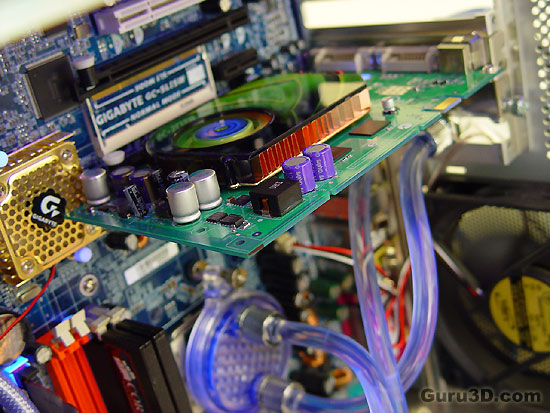Page 3
GeForce 7600 GT a.k.a. G73
Hurray! Finally a new mid-range product with a sweet performance boost. Please understand that low and midrange products always sell the best. They aslo offer you more bang for your bucks and often are very tweakable to squeeze some more performance out of them. The GeForce 7600 GT is a very competitive product in the mid-range market. I guarantee it, you'll be stunned by it's performance and at the time of this writing I haven't even tested it. How do I know that? It's specifications just look that good.
Armed with the development codename G73, the chip again was made on the newer 90nm fabrication process. For a mid-range product it has a rather large transistor count, no less than 177 million transistors can be found on the GeForce 7600 GT silicon.
Get this, 12 pixel pipelines running at a 560 MHz frequency with five active vertex processors. Again the product has eight ROPs. The memory however is still 128-bit whereas I hoped it would have been boosted to 256-bit. But it's really fast clocked memory namely 1400 MHz (2x700) and that is looking to be quite okay in my eyes. Judging from the specifications this product should be able to compete with the lower segment of current high-end cards such as the GeForce 6800 GT.
The card is targeted at a very wide audience with a sales price of 199 USD, which might sound a bit on the high side, but I expect prices to fall fast in the upcoming weeks as availability should be really good. Also, this product is a 256MB version as mid-range is now moving on to that amount of memory
Just like the 6600 GT the 7600 GT has SLI support which we'll put to the test. And since it's a Series 7 product you can expect dual-link DVI for extremely high resolution gaming up-to 2560x1600 (XHD as the industry would love to call that = Extreme High Definition) and all the sweetness in the form of HDR support and that finally important Shader Model 3.
 The GeForce 7600 GT 256MB
The GeForce 7600 GT 256MB
Now then, back to our usual technical blurb: What are the major advantages of the Series 7 products?
What you need to remember is that any Series 6 and 7 graphics card can achieve what a modern game expects from it. Obviously the keyword over the past couple of years has been "Shader technology." It really changed the way we look at games from a graphical point of view. It allows the game programmers to take games to a next level in both a visual and performance terms.
As always, that's the point where we land and quickly discuss on Shader Model 3.
Talking about Shader Model 3
If you program or play computer games or even recently attempted to purchase a video card, then you will have no doubt heard the terms "Vertex Shader" and "Pixel Shader". The step from 2.0 to 3.0 was a small one and most Shader Model 2.0 games can easily be upgraded to Model 3.0, which can bring more performance to that gaming experience. DirectX 9 was recently updated and we are going to see more and more support for 3.0 Shaders.
Is SM 3.0 technology a huge visual advantage over 2.0? Nope, not even the slightest bit. Yet any technological advantage is always welcome and preferred over a previous generation's development. What you need to remember about Shaders 3.0 is that it can and will be used only in several critical places where it can give a performance boost and graphics cards are all about performance my friends. Both ATI and NVIDIA now offer Shader Model 3 support in their new products. GeForce Series 6 and newer models and for ATI their X1000 series and newer models.
Talking about HDR
Another big trendy implementation that will bring games closer to a movie like quality experience is HDR.
Both ATI and NVIDIA
have been focusing extremely hard on HDR. They put a lot of money into their technology to support HDR in the best possible way and they should as it just is a fantastic effect that brings so much more to the your gameplay experience. HDR is something you all know from games like Far Cry. It's extremely bright lighting that brings a really cool cinematic effect to gaming. This effect is becoming extraordinarily popular.Valve recently released a new HL2 level in the form of Half Life 2: Lost Coast. Go download it as it'll show and amaze you what HDR can do. The difference is obvious. HDR means High Dynamic Range. HDR facilitates the use of color values way beyond the normal range of the color palette in an effort to produce a more extreme form of lighting rendering. Typically this trick is used to contrast really dark scenery. Extreme sunlight, over-saturation or over exposure is a good example of what exactly is possible. The most simple way to describe it would be controlling the amount of light used present in a certain position in a 3D scene.



Half Life 2 - Lost Coast level. If you bought the game, available for free on Steam.
HDR is already present in Far Cry, 3DMark06, Splinter Cell: Chaos Theory and in Half Life 2: Lost Coast. It will be available in Unreal 3 and likely a large number of other games. Let the screenshots do the talking.
